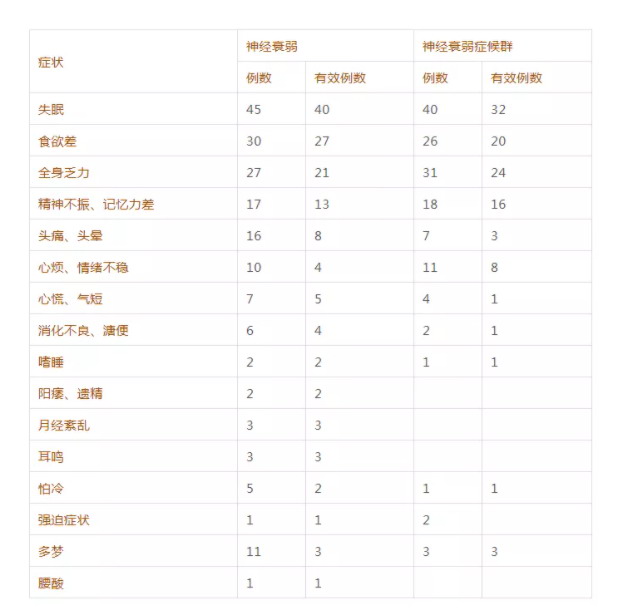
Tossing and turning.
Turn on the phone and see that it is already 2 am.
Repeated insomnia.
Black eyebags.
After getting up early, you feel exhausted again.

The above is a common phenomenon in many people. The disease that this kind of people suffers may be “neurasthenia”. Neurasthenia is a common and frequently-occurring disease in today’s society, and its main manifestations are sleep disorders, including difficulty falling asleep, difficulty falling asleep or waking up early. A survey of middle-aged people in our provinces and cities pointed out that 66% of people have insomnia, dreams and difficulty falling asleep, and 57% have memory loss. In addition, women are much more likely to suffer from neurasthenia than men.
Ten typical symptoms of neurasthenia
1. Easy fatigue is often manifested as mental and physical fatigue and daytime drowsiness.
2. Inattention is also a common symptom of neurasthenia.
3. Memory loss is characterized by recent memory loss.
4. Unresponsiveness is also a common symptom of neurasthenia.
5. Thoughtfulness, frequent recall and increased associations are excitatory symptoms of neurasthenia.
6. People with neurasthenia are also sensitive to sound and light.
7. Irritability is also one of the symptoms of neurasthenia. Generally, the mood is slightly better in the morning than in the evening.
8. People with a nervous breakdown are prone to sadness and pessimism.
9. Sleep disorders, difficulty falling asleep, dreaminess and restless sleep are also common symptoms of neurasthenia.
10. Patients with neurasthenia will also have tension headaches, which are manifested as swelling pain, precordial oppression and tightness.

Long-term neurasthenia and insomnia could lead to central nervous system disorder, neuron excitability and inhibition dysfunction, resulting in autonomic serve (sympathetic nerve and parasympathetic nerve) function disorder. Symptoms of the diease may include headaches, dizziness, failing memory, loss of appetite, palpitation, short breath, etc. As the disease progresses, dysfunctions in the endocrine and immune system may be diagnosed. Impotence, irregular menstruation or immunity deficiency could result. Eventually, the disordered nerve-endocrine-immune system becomes a part of a vicious cycle, which further deteriorates the neurasthenia patient’s health and well-being. Common hypnotics can only treat the neurasthenia symptoms. They do not resolve the root problem that lies in the nerve-endocrine-immune system of the patient. [The above text is selected from Lin Zhibin’s “Lingzhi, From Mystery to Science”, Peking University Medical Press, 2008.5 P63]

Reishi mushroom has a significant effect on insomnia for the neurasthenia patients. Within 1-2 weeks after the administration, patient’s sleep quality, appetite, weight-gain, memory and energy improved, and palpitation, headache and complications are relieved or eliminated. Actual therapeutic effects depends on dosage and treatment period of the specific cases. In general, larger doses and longer treatment periods tend to yield better results.
Some patients with chronic bronchitis, coronary heart disease, hepatitis and hypertension accompanied by insomnia can get better sleep after treatment with Ganoderma lucidum, which is also helpful for the treatment of the primary disease.
Pharmacological study showed that Lingzhi significantly decreased the autonomic activities, shorthened the sleep latency induced by pentobarbital, and increase the sleep time on pentobarbital-treated mice, indicating that Lingzhi has a sedation effect on the test animals.
Aside from its sedative function, Lingzhi’s homeostasis regulation effect might also have contributed to its efficacy on neurasthenia and insomnia. Through homeostasis regulation, Ganoderma lucidum could revive the disordered nerve-endocrine-immune system interrupting the neurasthenia-insomnia vicious cycle. Thereby, patient’s sleep could be improved and other symptoms relieved or eliminated. [The above text is selected from Lin Zhibin’s “Lingzhi, From Mystery to Science” Peking University Medical Press, 2008.5 P56-57]
Clinical report on the treatment of neurasthenia with Ganoderma lucidum
As early as the 1970s, the Integrated Traditional Chinese and Western Medicine Team of the Psychiatric Department of the Third Affiliated Hospital of Beijing Medical College discovered that Ganoderma lucidum had significant clinical effects on neurasthenia and residual neurasthenia syndrome in the recovery period of schizophrenia (hereinafter referred to as neurasthenia syndrome). Among the 100 tested cases, 50 had neurasthenia and 50 had neurasthenia syndrome. Ganoderma (sugar-coated) tablets are processed from Ganoderma lucidum powder obtained from liquid fermentation, each containing 0.25g Ganoderma lucidum powder. Take 4 tablets 3 times a day. A small number of people take 4-5 tablets 2 times a day. The common course of treatment is more than 1 month, and the longest treatment course is 6 months. Efficacy evaluation criteria: patients whose main symptoms disappeared or basically disappeared are regarded as significantly improved; some patients with improved symptoms are considered to have improved in symptoms; those with no change in symptoms after one month of treatment were deemed to have received ineffective treatment.
The results showed that after more than one month of treatment, 61 cases were significantly improved, accounting for 61%; 35 cases were improved, accounting for 35%; 4 cases were ineffective, accounting for 4%. The total effective rate is 96%. The significant improvement rate of neurasthenia (70%) is higher than that of neurasthenia syndrome (52%). In TCM classification, Ganoderma lucidum has a better effect on patients with deficiency of both qi and blood.
After treatment with Ganoderma lucidum, the symptoms of the two groups of patients were significantly improved (Table 8-1). After 2 to 4 weeks of medication, Ganoderma lucidum treatment is effective in most cases. The rate of patients experiencing significant improvement in the course of treatment for 2 to 4 months is relatively high.The curative effect has not been further improved for those who have been treated for more than 4 months.

(Table 8-1) The effect of Ganoderma lucidum tablets on the symptoms of neurasthenia and neurasthenia syndrome [The above text is selected from Lin Zhibin’s “Lingzhi, From Mystery to Science”, Peking University Medical Press, 2008.5 P57-58]

Pass on the Millennia Health Culture
Contribute to Wellness for All



